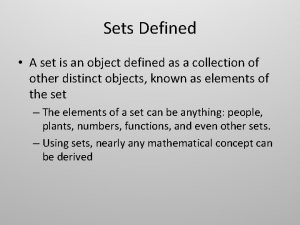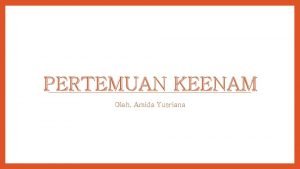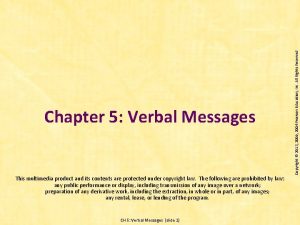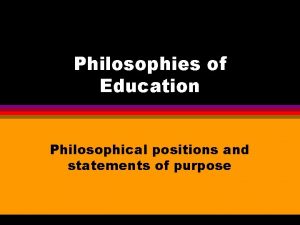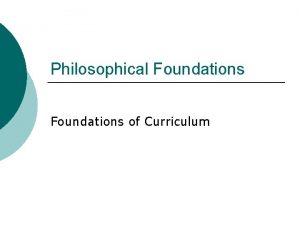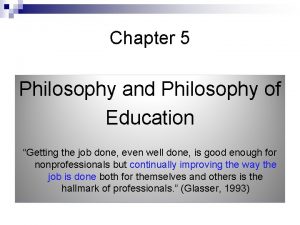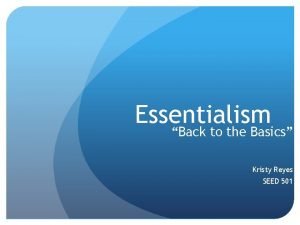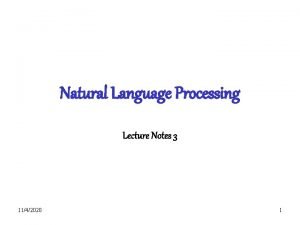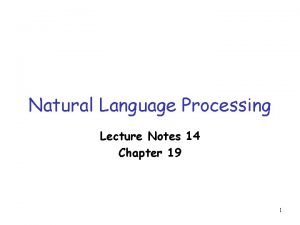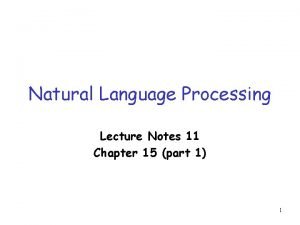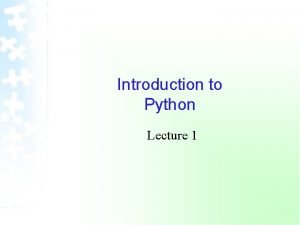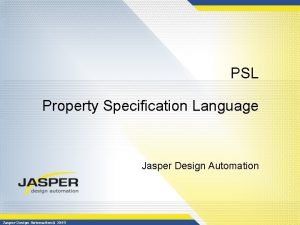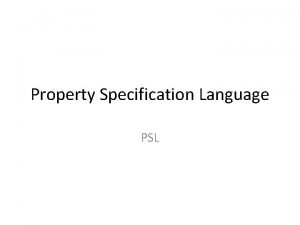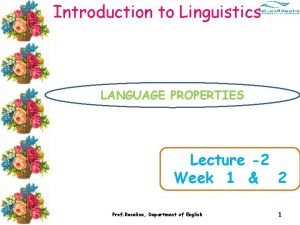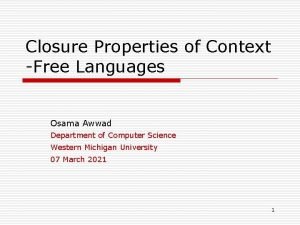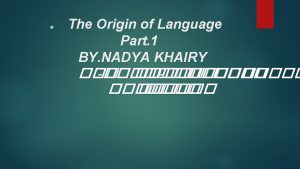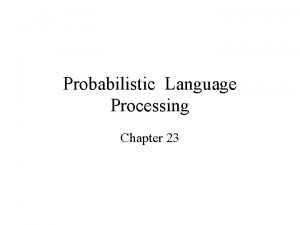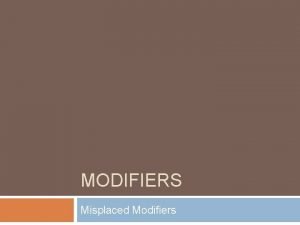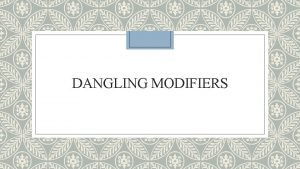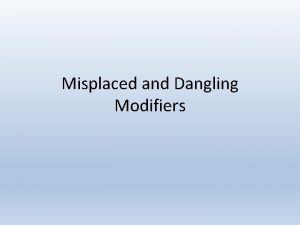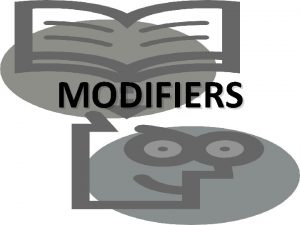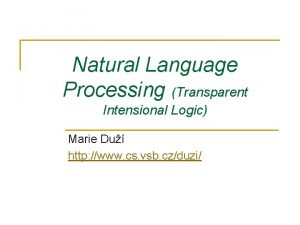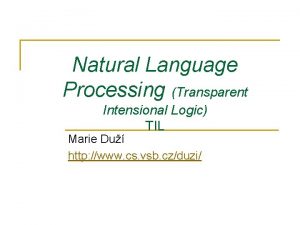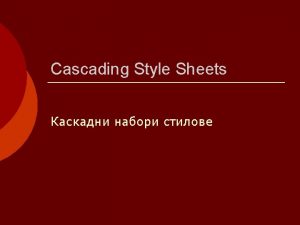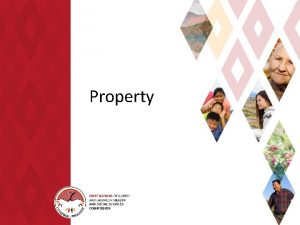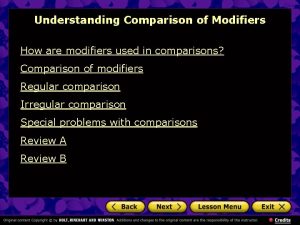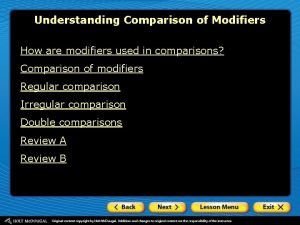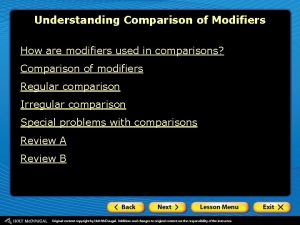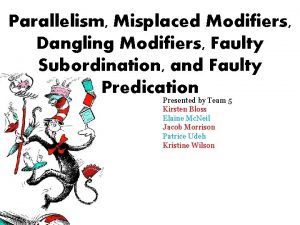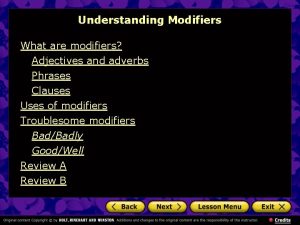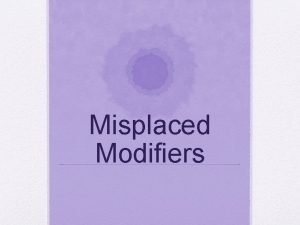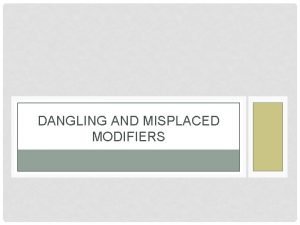Lecture 10 Property modifiers Intensional Essentialism Natural Language








 ⊢ The rules of left- and right-subsectivity (our goal) • Left subsectivity [M P](a) ⊢](https://slidetodoc.com/presentation_image_h2/9f3b904d450c8d006855a2fbdde0513f/image-9.jpg)
![TIL analysis • Types. M (( ) ) P ( ) ; [M P] TIL analysis • Types. M (( ) ) P ( ) ; [M P]](https://slidetodoc.com/presentation_image_h2/9f3b904d450c8d006855a2fbdde0513f/image-10.jpg)






![Right subsectivity, subsective vs. privative • Subsective Ms: [[Ms P]wt a] ⊢ [Pwt a] Right subsectivity, subsective vs. privative • Subsective Ms: [[Ms P]wt a] ⊢ [Pwt a]](https://slidetodoc.com/presentation_image_h2/9f3b904d450c8d006855a2fbdde0513f/image-17.jpg)





![subsective vs. privative, definition [[0 Ess 0 Lion] [0 Ess [0 Stony 0 Lion]]] subsective vs. privative, definition [[0 Ess 0 Lion] [0 Ess [0 Stony 0 Lion]]]](https://slidetodoc.com/presentation_image_h2/9f3b904d450c8d006855a2fbdde0513f/image-23.jpg)

![Privative modification • As a result, the modified property [Mp. P] and the property Privative modification • As a result, the modified property [Mp. P] and the property](https://slidetodoc.com/presentation_image_h2/9f3b904d450c8d006855a2fbdde0513f/image-25.jpg)





- Slides: 30

Lecture 10 Property modifiers (Intensional Essentialism) Natural Language Processing Marie Duží

Property modifiers • Intersective modifiers a is a round peg ⊢ a is round & a is a peg • Subsective modifiers a is a skillful surgeon ⊢ a is a surgeon & a is skillful (? ) • Privative modifiers a is a forged banknote ⊢ a is not a banknote, a is a non banknote, a is forged (? ) • Modal modifiers a is an alleged assassin ⊢ hence what? an alleged assassin is or is not an assassin; I do not deal with modal modifiers like alleged, which appear to be well nigh logically lawless 2

Property modifiers paradoxes ? Jumbo is a small elephant Jumbo is small Mickey is a large mice Mickey is larger than Jumbo (? ) Jumbo is a small elephant Jumbo is small Jumbo is a mammal Jumbo is a small mammal (? ) 3

Property modifiers • The major difference between subsective and intersective modification is that subsectivity bans this sort of argument: [Ms. P](a), Q(a) ⊢ [Ms. Q](a) • Tilman may be a skillful surgeon, surgeon and he may be a painter too, but this does not make him a skillful painter. • Tilman is skillful as a surgeon rather than as a painter • Jumbo may be a small elephant, as well as a mammal, but this does not make Jumbo a small mammal. • Jumbo is small as an elephant rather than as a mammal. • Scalar adjectives like ‘small’, ‘big’ or ‘skillful’ represent subsective modifiers. • to each intersective modifier Mi there is a unique ‘absolute’ property M* such that if a is an [Mi P] then a is M* not only as a P but absolutely. 4

Intersective modifiers • “If a is a round peg, then a is round a is a peg”. [Mi P](a) ⊢ M*(a) P(a). {[Mi P]} = {M*} {P}. • Necessarily, i. e. in all worlds and times, the set of round pegs equals to the intersection of the sets of round objects and pegs. • Intersectivity is the least interesting form of modification, since antecedent and consequent, or premise and conclusion, are equivalent. Still, even in the case of the apparently logically trivial intersectives we cannot transfer Mi from the premise to the conclusion. • a modifier cannot also occur as a predicate; predicate these are objects of different types. Hence M* instead of just M. 5

Subsective & privative modifiers • “If a is a skillful surgeon, then a is a surgeon. ” [Ms. P](a) ⊢ P(a) • Necessarily, {[Ms. P]} {P}. Necessarily, i. e. in all worlds and times, the set of skillful surgeons is a subset of the set of surgeons. • “If a is a forged banknote, then a is not a banknote”. [Mp. P](a) ⊢ P(a) • Necessarily, {[Mp. P]} {P} = Necessarily, i. e. in all worlds and times, the intersection of the set of forged banknotes and banknotes is empty. 6

Privation • Forged is privative; hence a forged banknote is not a banknote that is forged, such that there would be two kinds of banknotes: those that are genuine and those that are forged. • The sum of four genuine banknotes and one forged banknote is four banknotes and not five (though five pieces of paper). • This is also to say that Genuine is an idle modifier: a is a genuine F iff a is an F. • {Genuine banknote} = {banknote}; {Forged banknote} {banknote} some forged banknotes are genuine banknotes – contradiction! contradiction • This is not to say that the same material object may not be genuine in one respect and fail to be genuine in another. • For instance, an artefact being passed off as a paper banknote may fail to be a banknote (being a forged banknote), while being indeed made of paper (rather than polymer, say), thereby being a paper artefact. (“The banknote is fake, the paper is real”). • In colloquial speech we may ask, “Is this a genuine banknote or a Monopoly banknote? ”, where it would be sufficient to ask, “Is this a banknote or a Monopoly banknote? ”, Monopoly having the effect of a privative modifier not unlike toy in being a toy gun. 7

With respect to a property … • Modifiers are intersective, subsective and privative with respect to a property P. • One and the same modifier can be intersective with respect to a property P and privative with respect to another property Q. • For instance, a stone bridge is stony and is a bridge, but a stone lion is not a lion. • We leave aside the question whethere are modifiers privative with respect to any property. • Most probably, not; modifiers like faked, forged, false might appear to be privative with respect to any property. Yet, a fake banknote is fake as a banknote but it is a genuine piece of plastic or paper or whatever it is made of 8
 ⊢](https://slidetodoc.com/presentation_image_h2/9f3b904d450c8d006855a2fbdde0513f/image-9.jpg)
The rules of left- and right-subsectivity (our goal) • Left subsectivity [M P](a) ⊢ M*(a) for all kinds of modifiers, where M* is the property of being an “M something” Or, in TIL notation • Right subsectivity 1. Subsective, intersective in TIL notation [[M P]wt a] ⊢ [M*wt a] [M P](a) ⊢P(a) [[M P]wt a] ⊢ [Pwt a] 2. Privative [M P](a) ⊢non-P(a) where non P is a property contrary to P rather than contradictory in TIL notation [[M P]wt a] ⊢ [non-Pwt a] 9
![TIL analysis Types M P M P TIL analysis • Types. M (( ) ) P ( ) ; [M P]](https://slidetodoc.com/presentation_image_h2/9f3b904d450c8d006855a2fbdde0513f/image-10.jpg)
TIL analysis • Types. M (( ) ) P ( ) ; [M P] ( ) • Modifiers are analytical functions that given a property P as an argument return as its value another (modified) property [M P] • Why analytical? Why not empirical, i. e. M (( ) ) ? • It is a purely linguistic issue that for instance ‘wooden’ applied to ‘horse’ gives the property ‘wooden horse’; it does not depend on state of affairs which property the wooden horse is. 10

TIL analysis and proofs; left subsectivity The rule of ‘pseudo detachment’: pseudo detachment a is an MP (PD) a is an M* M/(( ) ); M*/( ) if the customs officers seize five forged banknotes and two forged passports, they may want to lump together all the forged things they have seized that day, abstracting from the particular nature of the forged objects, to come to the conclusion that they seized seven forged (things). This lumping together is feasible only if it is logically possible to, as it were, abstract forged from a being a forged A and b being a forged B to form the new predications that a is forged (something) and that b is forged (something – possibly else), which are subsequently telescoped into a conjunction. 11

TIL analysis and proofs; left subsectivity • Types. = ( ) for short, M ( ) a modifier, P an individual property, [MP] the property resulting from applying M to P; a ; =/( ); p v ; x v . • the proof of the rule: 1. [[MP]wt a] 2. p [[Mp]wt a] 3. [ x p [[Mp]wt x] a] 4. [ w’ t’ [ x p [[Mp]w’t’ x]]wt a] 5. M* = w’ t’ [ x p [[Mp]w’t’ x]] 6. [M*wt a] assumption 1, EG 2, expansion 3, expansion definition 4, 5, SI 12

TIL analysis and proofs; left subsectivity • (PD), dressed up in full TIL notation, is this: [[MP]wt a] [M* = w t x p [[Mp]wt x]] (PD) ––––––––––––– [M*wt a] • Additional type: /( ( )) • This rule is valid for all kinds of modifiers. • In case of intersective modifiers the property M* is one and the same for any property p • Round peg is round not only as a peg but as any thing, ‘absolutely’ 13

TIL analysis and proofs; Left subsectivity John has a forged banknote and a forged passport John has two forged things w t xy [[0 Have wt 0 John x] [0 Have wt 0 John y] [[0 Forged 0 Banknote] wt x] [[0 Forged 0 Passport] wt y] [0 x y]] –––––––––––––––––––––––––– w t xy [[0 Havewt 0 John x] [0 Have wt 0 John y] [0 Forged* wt x] [0 Forged* wt y] [0 x y]] –––––––––––––––––––––––––– w t [0 Number_of x [[0 Have wt 0 John x] [0 Forged* wt x]] = 02] • Types: Number_of/( ( )); Banknote, Passport, Forged*/( ) ; Have/( ) ; Forged/(( ) ). 14

Left subsectivity, objections • First objection. If Jumbo is a small elephant and if Jumbo is a big mammal, then Jumbo is not a small mammal; hence Jumbo is small and Jumbo is not small Contradiction! w t [[0 Small 0 Elephant]wt 0 Jumbo] w t p [[0 Small p]wt 0 Jumbo] w t [[0 Big 0 Mammal]wt 0 Jumbo] w t q [[0 Big q]wt 0 Jumbo] Types: Small, Big/( ); Mammal, Elephant/ ; Jumbo/ ; p, q . To obtain a contradiction, we would need an additional premise w t p [[[0 Big p]wt 0 Jumbo] [[0 Small p]wt 0 Jumbo]] But, in the above arguments p q. Hence, no contradiction. • nobody and nothing is absolutely small or absolutely large; everybody is made small by something and made large by something else. • nobody is absolutely good or absolutely bad; everybody has something they do well and something they do poorly. That is, everybody is both good and bad, which here just means being good at something and being bad at something else, without generating paradox 15

Left subsectivity, objections • Second objection. The use of pseudo detachment, together with an innocuous sounding premise, makes the following argument valid. Jumbo is a small elephant and Mickey is a big mouse Jumbo is small Mickey is big If x is big and y is small, then x is bigger than y Mickey is bigger than Jumbo. • w t x y p [[[[0 Small p]wt x] [[0 Big p]wt y]] [0 Biggerwt p y x]] • Again, contradiction cannot generated from the above premises, because p q: w t [ p [[0 Small p]wt 0 Jumbo] q [[0 Big q]wt 0 Mickey]]] 16
![Right subsectivity subsective vs privative Subsective Ms Ms Pwt a Pwt a Right subsectivity, subsective vs. privative • Subsective Ms: [[Ms P]wt a] ⊢ [Pwt a]](https://slidetodoc.com/presentation_image_h2/9f3b904d450c8d006855a2fbdde0513f/image-17.jpg)
Right subsectivity, subsective vs. privative • Subsective Ms: [[Ms P]wt a] ⊢ [Pwt a] • A skillful surgeon is a surgeon; a wooden table is a table • Privative Mp: [[Mp P]wt a] ⊢ [non Pwt a] • A forged banknote is a non banknote; a wooden horse is a non horse • To define these modifiers rigorously, we apply the method of intensional essentialism • Contra individual anti essentialism: anti essentialism individuals do not have any non trivial empirical property necessarily, merely contingently • Every property we countenance has a host of other properties necessarily associated with it. • For instance, the property of being a bachelor is associated with the properties of being a man, being unmarried, and many others. • Necessarily, if a happens to be a bachelor then a is a man and a is unmarried. • We call these adjacent properties requisites of a given property. 17

subsective vs. privative, definition Definition (requisite relation between properties). Let P, Q be constructions of individual properties; P, Q/ n ( ) ; x . Then [0 Req Q P] =df w t [ x [[0 Truewt w t [Pwt x]] [0 Truewt w t [Qwt x]]]] • Our essentialism is based on the idea that since no purely contingent property can be essential of any individual, essences are borne by intensions rather than by individuals exemplifying intensions • That a property P has an essence means that a relation in extension obtains a priori between the property P and a set Ess of the requisites of P Definition (essence of a property). Let p, q ( ) be constructions of individual properties, and let Ess/(( ( ) ) be a function assigning to a given property p the set of its requisites defined as 0 Ess = p q [0 Req q p]. Then the essence of a property p is the set of its requisites: [0 Ess p] = q [0 Req q p] 18

subsective vs. privative, definition • The question is, how do we know which are the requisites of a given property? • The answer requires an analytic definition of the given property, which amounts to the specification of its essence. (machine learning. . . ) • For instance, the simple term ‘cat’ expresses the simple, least informative concept of a cat: 0 Cat • To obtain an analytic definition, we can apply a biological taxonomy: • The domestic cat belongs to the kingdom Animalia, which includes all animals. • Cats have backbones, which places them in the phylum Chordata and the subphylum Vertebrata. • Because cats have hair, three middle ear bones and mammary glands, which produce milk for their young, they belong to the class Mammalia, which includes all mammals. • Cats are meat eaters in the order Carnivora. Cats are among the most carnivorous of the carnivores, feeding almost exclusively on meat • Domestic and wild cats make up the family Felidae. This family is characterized by short muzzles and a reflective membrane over their eyes, which gives them excellent vision. 19

subsective vs. privative, definition • Since modifiers change the essence of the root property, we need to compare the essences, that is sets of requisites, of the root and modified property Definition (subsective vs. privative modifiers). Let the types be: P ( ) , M (( ) ), p ( ) , x . Then • A modifier M is subsective with respect to a property P iff [0 Ess P] [0 Ess [M P]] • A modifier M is non trivially subsective with respect to a property P iff [0 Ess P] [0 Ess [M P]] • A modifier M is privative with respect to a property P iff [[0 Ess P] [0 Ess [M P]] 0 p [[[0 Ess P] p] [[0 Ess [M P]] w t [ x [p x]]]]. wt 20

subsective vs. privative, definition EXAMPLE. • The modifier Stony/(( ) ) is subsective with respect to the property of being a bridge, Bridge/( ) , but privative with respect to the property of being a lion, Lion/( ) . • Of course, a stony bridge is a bridge, but the essence of the property [0 Stony 0 Bridge] is enriched by the property of being stony. This property is a requisite of the property of being a stony bridge, but it is not a requisite of the property of being a bridge, because bridges can be instead made of wood, iron, etc. [0 Ess 0 Bridge] [0 Ess [0 Stony 0 Bridge]] • Each stony bridge is a bridge: [0 Stony 0 Bridge]wt 0 Bridgewt 21

subsective vs. privative, definition • But a stony lion is not a lion. • The modifier Stony, the same modifier that just modified Bridge, deprives the essence of the property of being a lion, Lion/( ) , of many requisites, for instance, of the property of being an animal, having a bloodstream, a heartbeat, etc. Thus, among the requisites of the property [0 Stony 0 Lion] there are properties like not being a living thing, not having a bloodstream, etc. , which are contradictory (not just contrary) to some of the requisites of the property Lion. • On the other hand, the property [0 Stony 0 Lion] shares many requisites with the property of being a lion, like the outline of the body, having four legs, etc. , and has an additional requisite of being made of stone. We have: 22
![subsective vs privative definition 0 Ess 0 Lion 0 Ess 0 Stony 0 Lion subsective vs. privative, definition [[0 Ess 0 Lion] [0 Ess [0 Stony 0 Lion]]]](https://slidetodoc.com/presentation_image_h2/9f3b904d450c8d006855a2fbdde0513f/image-23.jpg)
subsective vs. privative, definition [[0 Ess 0 Lion] [0 Ess [0 Stony 0 Lion]]] [[0 Ess 0 Lion] 0 Living_thing] [[0 Ess [0 Stony 0 Lion]] w t [ x [0 Living_thingwt x]]] [[0 Ess 0 Lion] 0 Blood] [[0 Ess [0 Stony 0 Lion]] w t [ x [0 Bloodwt x]]] • etc. 23

Privative modification • A modifier M is privative with respect to a property P iff the modified property [M P] lacks at least one, but not all, of the requisites of the property P. • However, in this case we cannot say that the essence of the property [M P] is a proper subset of the essence of the property P, because the modified property [M P] has at least one other requisite that does not belong to the essence of P, because it contradicts to some of the requisites of P. • Hence, M is privative with respect to a property P iff the essence of the property [M P] has a non empty intersection with the essence of the property P, and this intersection is a proper subset of both the essences of P and of [M P]. • For instance, a well forged banknote has almost the same requisites as does a banknote, but it has also another requisite, namely the property of not being acceptable as money that contradicts the ‘original’ requisite of being acceptable as money. 24
![Privative modification As a result the modified property Mp P and the property Privative modification • As a result, the modified property [Mp. P] and the property](https://slidetodoc.com/presentation_image_h2/9f3b904d450c8d006855a2fbdde0513f/image-25.jpg)
Privative modification • As a result, the modified property [Mp. P] and the property P are contrary rather than contradictory properties: w t x [[[Mp. P]wt x] [Pwt x]] w t x [ [[Mp. P]wt x] [Pwt x]] • It is not possible for x to co instantiate [Mp. P] and P, and possibly x instantiates neither [Mp. P], nor P. • For instance, compare ‘gun’ vs. ‘toy gun’. There are many things that are neither guns nor toy guns. Yet, if something happens to be a gun, then it is not a toy gun. • First conjunct: [Mp. P] and P are mutually exclusive. This is because among the requisites of the properties P and [Mp. P] there is at least one pair of mutually contradictory properties • The second conjunct is the contrariety clause that the negation of one of the conjuncts [Mp. P]wt x , Pwt x does not entail the truth of the other one. 25

Iterated privation M p Mp F • Since M p is privative with respect to Mp F , [0 Ess M p Mp F ] [0 Ess Mp F ] • And since Mp is privative with respect to F, [0 Ess Mp F ] [0 Ess F • Moreover, this sharing some of the requisites is transitive [0 Ess M p Mp F ] [0 Ess F] Question: what is the relation between M p Mp F and F ? ? ? 26

Iterated privation M p Mp F • Recall the earthquakes in central Italy in 2016. • Many houses, bridges and other buildings and constructions were damaged, some beyond repair. • A demolished damaged house is not a house • but debris: a particular object goes through the stages of being a house, then a damaged house and finally a demolished damaged house, which is in material terms nothing but debris; such is the semantics of the adjective ‘demolished’. • a demolished damaged house is different from a demolished damaged bridge A demolished damaged house shares requisites with houses that it does not share with demolished damaged bridges. 27

Iterated privation • It may, but does not have to, so happen that [[0 Ess F] [0 Ess M p Mp F ]] • Hence, [M p Mp F x] [F x] • For instance, a repaired damaged house is again a house • To repair a damage is to undo the damage and in so doing returning the previously damaged artefact to its still earlier state of functioning properly; such is the semantics of the verb ‘to repair’ and the adjective ‘repaired’. • modifier repaired is privative with respect to damaged house, because what is a non house turns into a house. Formally: [[0 Ess 0 House] [0 Ess [0 Repaired [0 Damaged 0 House]]]] 28

M p Mp F vs. F Iterated privation issues in a trifurcation of cases: i. a is an F (repaired damaged house is a house) ii. a fails to be an F (demolished damaged house is not a house) iii. it is semantically indeterminate whether a is an F (former heir apparent) • If somebody is anything but a false friend then they are a friend (and that to a very high degree) • If something weighs almost half a kilo then it weighs less than a kilo and, therefore, does not weigh a kilo • If someone is a former heir apparent then either they are now the incumbent monarch or they are no longer being even considered for the throne 29

M p Mp F vs. F • In all the three cases M p Mp F has something in common with an F (at least one property in the essence) • Hence, M p Mp F M p Mp G 30
 Intensional definition
Intensional definition Contoh orientasi intensional
Contoh orientasi intensional Intensional orientation
Intensional orientation Experimentalism in education
Experimentalism in education Curriculum trends in perennialism
Curriculum trends in perennialism Educational philosphies
Educational philosphies Progressivism educational philosophy
Progressivism educational philosophy Who are referred to as teachers in batas pambansa 232?
Who are referred to as teachers in batas pambansa 232? Strengths and weaknesses of essentialism in education
Strengths and weaknesses of essentialism in education Natural language processing
Natural language processing Natural language processing lecture notes
Natural language processing lecture notes Natural language processing lecture notes
Natural language processing lecture notes Natural language processing lecture notes
Natural language processing lecture notes Natural language processing lecture notes
Natural language processing lecture notes Natural language processing lecture notes
Natural language processing lecture notes 01:640:244 lecture notes - lecture 15: plat, idah, farad
01:640:244 lecture notes - lecture 15: plat, idah, farad Associative vs commutative
Associative vs commutative Classification of property under hindu law
Classification of property under hindu law Chemical property definition
Chemical property definition Big picture lecture language
Big picture lecture language English language lecture
English language lecture Natural hazards vs natural disasters
Natural hazards vs natural disasters Natural income
Natural income Property specification language
Property specification language Hardware specification example
Hardware specification example Properties of language
Properties of language Cfl closed under intersection
Cfl closed under intersection Natural language processing vietnamese
Natural language processing vietnamese Glossogenetics
Glossogenetics Probabilistic model natural language processing
Probabilistic model natural language processing Markov chain natural language processing
Markov chain natural language processing
